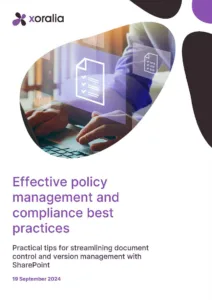7 steps to roll out a new workplace policy
- Dan Hawtrey

From time-to-time organisations will need to introduce a new workplace policy or procedure, or make a significant change to a policy that then needs to be rolled out to employees who need to be made aware about it, and the relative changes involved. For example, recently many organisations have introduced new policies on remote and hybrid working that everybody needs to be aware of. Other areas where policy and policy changes are important can relate to security and compliance, the introduction of new processes, or new ways of working.
Rolling out a new workplace policy is something that requires some planning. You can’t just email out the policy to everybody and hope for the best. Taking a structured approach that follows all a number of different steps helps to ensure the policy is fully disseminated to all employees and that the changes are understood.
In this article we’re going to cover seven steps you need to follow to ensure the successful roll-out of a new workplace or employee policy.
Ensure the policy has been agreed upon by all stakeholders
This might sound obvious, but before you roll out the policy you need to make sure that the policy has been properly reviewed and agreed upon by all the necessary stakeholders. In our experience, this is an area which is ripe for misunderstanding, and there is nothing worse than rolling out a policy only to find someone needs to change it.
Getting agreement and consensus on a policy involving multiple stakeholders can be like herding cats, and inevitably some stakeholders will come up with feedback and alterations at the very last moment. People can get very particular on specific wording too. Always double- check and then triple-check that the policy has been finalised and approved by all stakeholders before rolling it out.
Create a launch plan with roles and a timetable
Launching a new policy is like a rolling out a marketing campaign or even an IT application. You need to have an overarching launch plan. This will have all the necessary people and roles involved in the roll-out, a detailed timetable and an idea of the main steps involved. Once you have a draft plan in place this then needs to circulated to and agreed upon by all those involved.
Usually having a planning meeting with the launch team giving input will help get them on board, and also finalise any plan.

Work on the communications plan too
A key part of any launch plan for a new policy is having a good communications plan to introduce the policy that takes in the desired channels you’re going to use, the right messaging and the diversity of your workforce. This means your plan cover what you are trying to convey, the different audiences you are trying to reach and so on. In working out the plan, the kind of questions that need to be considered might be:
- What messages are we trying to convey in the campaign?
- Which channels are we going to use to actually disseminate the policy?
- What channels are we going to use to communicate about the policy?
- Do we need to run any training sessions?
- Do frontline employees have access to the policy and communications about it?
- Are there any other groups such as contractors who will need to know about the policy but might not have access to key channels?
- Who is the person, if any, who is fronting the campaign; for example, is your CEO going to put their name behind communications relating to the new policy?
- Considering the diversity of the workforce and the nature of the policy being launched, do communications and the policy need to be translated into different languages?
- How long does the campaign last?
- Do we need to target the messaging and content to different groups detailing what the change in policy means for them?
- How do we deal with any questions about the policy?
Prepare any communications covering the “why” and the “what”
With a campaign plan made, it’s time to create any necessary communications relating to the policy. This could include making a summarized and more digestible version of the policy itself that is more likely to be read and understood than a very long document that is written in “legalease” and risks getting ignored.
Another important approach in preparing communications to launch a new policy is to ensure messaging covers both the “why” and the “what”. Providing the full context and the reasons for introducing the new policy is essential for driving compliance across employees. This then positions the “what” which explains the implications of the new policy for how people work and any required new ways of doing things.
It also helps to prepare managers and team leaders about the campaign, particularly if they are going to be involved in helping to disseminate the policy to their team and then monitoring the related employee attestation process.

Prepare the right digital channels
Your launch and communication plan will involve preparing various digital channels to both distribute the policy and also to issue any communications about it. You need to ensure that the channel where the policy is actually housed is something that all employees can access such as your company intranet or an appropriate policy management solution. For example, the Xoralia platform seamlessly integrates with your SharePoint Online or Microsoft 365 digital workplace so policies are easily accessed by anybody with a Azure Active Directory ID. Other channels you may leverage for communications could include your intranet, email and Microsoft Teams.
Use an employee attestation process
As part of the roll-out of the policy, particularly if it is compliance-related, run an employee attestation process that confirms every employee has read and understood the new policy. This can have two elements; firstly, getting each employee to supply an online confirmation they have read and understood the policy. Secondly, you can also ask questions about the policy using an online quiz to make sure employees have digested it.
In powerful policy management software like Xoralia you can manage the whole employee attestation process from end-to-end, preparing an online confirmation, a quiz if required and using in-built reporting to track who has and hasn’t completed the process. It even includes automated notifications to send out reminders to anyone who has yet to confirm they’ve read the policy.
Chase all responses and embed the policy in onboarding
Once the attestation process has kicked off you then need to chase all responses so everybody in your company has confirmed that they have read and understood the policy. Using the very granular reporting on a solution like Xoralia means that managers can follow up with individual team members to ask them to complete the attestation process if required.
After this process, you may need to embed reading the new policy into your company’s standard employee onboarding process, adding it to the list of required reading. Some policy management solutions can help with this; for example, with Xoralia adding a new person to the appropriate Active Directory group when they join can automatically trigger the related onboarding and attestation process for that individual.

Rolling out a new policy
Rolling out a new policy is an important activity that needs to happen from time to time. By following the seven steps detailed above and using a solution like Xoralia, you’ll be able to successfully launch your policy and ensure it has been digested by employees.
If you’d like to discuss how Xoralia can help you roll out policies and procedures, then get in touch!
The story behind Xoralia
 Xoralia was built by the team at Content Formula, an intranet and digital workplace consultancy that has built SharePoint intranets for some of the world’s most famous companies. Now, most companies want their policies and procedures on the intranet but they don’t just want to store them there, they also want tools to help better manage them. Over the years we came across just about every single requirement for a policy management system. As this article above explains, there are gaps in SharePoint and so we never built what in our mind was the perfect policy management system.
Xoralia was built by the team at Content Formula, an intranet and digital workplace consultancy that has built SharePoint intranets for some of the world’s most famous companies. Now, most companies want their policies and procedures on the intranet but they don’t just want to store them there, they also want tools to help better manage them. Over the years we came across just about every single requirement for a policy management system. As this article above explains, there are gaps in SharePoint and so we never built what in our mind was the perfect policy management system.
However, one of our clients challenged us to build something for them that filled all the gaps but still used SharePoint at the back end. We had a great relationship with them and agreed to share the budget to do this, provided we could then market the solution to others. That was in 2019. We’re now on version 3 of Xoralia and the product has grown and evolved a lot.
3 benefits you can expect from Xoralia
Make it easy to find policies
Centralised policy library with powerful search and filtering.
Reduce administrative burden
Automations and notifications so that all policy tasks are carried out on time
Demonstrate compliance and best practice
Sophisticated tracking and dashboards to drive and measure compliance.
And lots more!
What our clients say

AppSource review
A great time saver and tool for document management

Tim Galer
IT Coordinator
Hughes
Ideal partner for our regulated environment

Adam Lythgoe
IT Manager
LifeArc
How to get started with Xoralia
Step 1: request a demo
Fill out our form and we will be in touch to arrange a time. You can even book a time yourself.
Step 2: get a price proposal
If you think Xoralia is for you ask us for a quote. This will set out any options you may have.
Step 3: install and launch
We’ll install Xoralia in your environment (or you can do it yourself). We’ll provide training and support to get you up and running quickly.
Here's what you'll get
-
Central policy library
-
Search and filter tools
-
Mandatory read policies with attestations
-
Quizzes
-
Notifications and alerts
-
Employee dashboard
-
Line manager dashboard
-
Works on mobile, in Teams and SharePoint
-
New policy creation workflows
-
Policy update workflows
-
Review and approval gates
-
Policy version history
-
Compliance dashboard
-
Audit trail
-
Full reporting
And last but not least:
-
Professional implementation service and support
-
Evergreen software – frequent updates and improvements
-
Comes with our "it just works" support warranty – we’ll fix any bugs, often before you even notice
Ready to get started?
Connect with us to streamline your policy management and ensure effortless compliance.

AppSource review
Uniting excellence in integration and features for seamless policy management

Rian Stuart
IT Manager
TwinStream
